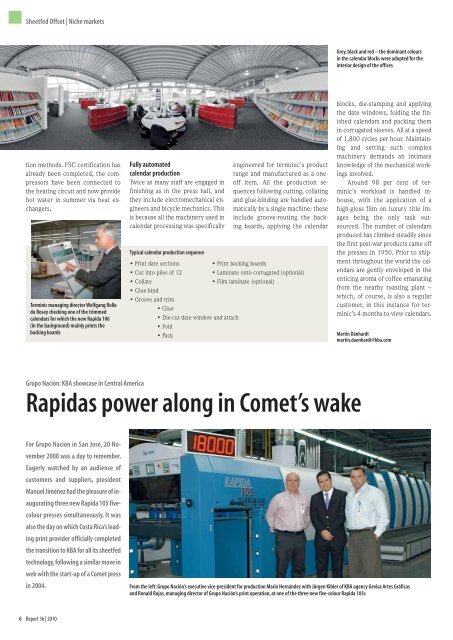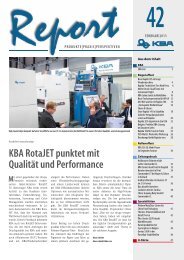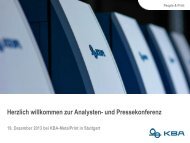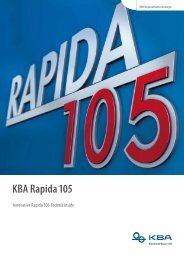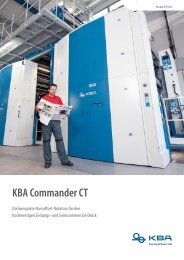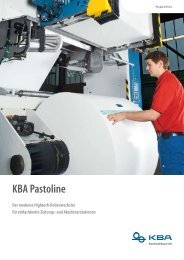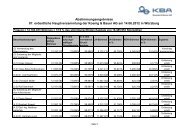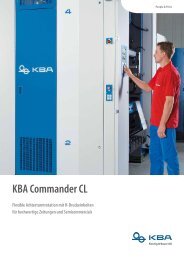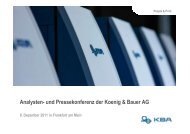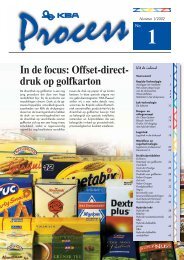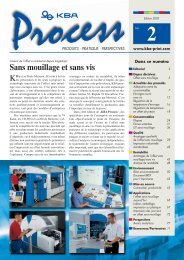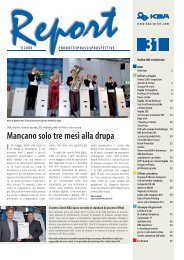Report 36 d,e,f,s,i.qxd:Report - KBA
Report 36 d,e,f,s,i.qxd:Report - KBA
Report 36 d,e,f,s,i.qxd:Report - KBA
You also want an ePaper? Increase the reach of your titles
YUMPU automatically turns print PDFs into web optimized ePapers that Google loves.
Sheetfed Offset | Niche markets<br />
tion methods. FSC certification has<br />
already been completed, the compressors<br />
have been connected to<br />
the heating circuit and now provide<br />
hot water in summer via heat exchangers.<br />
Terminic managing director Wolfgang Rolla<br />
du Rosey checking one of the trimmed<br />
calendars for which the new Rapida 106<br />
(in the background) mainly prints the<br />
backing boards<br />
Grupo Nación: <strong>KBA</strong> showcase in Central America<br />
Rapidas power along in Comet’s wake<br />
For Grupo Nación in San José, 20 November<br />
2008 was a day to remember.<br />
Eagerly watched by an audience of<br />
customers and suppliers, president<br />
Manuel Jiménez had the pleasure of inaugurating<br />
three new Rapida 105 fivecolour<br />
presses simultaneously. It was<br />
also the day on which Costa Rica’s leading<br />
print provider officially completed<br />
the transition to <strong>KBA</strong> for all its sheetfed<br />
technology, following a similar move in<br />
web with the start-up of a Comet press<br />
in 2004.<br />
6 <strong>Report</strong> <strong>36</strong> | 2010<br />
Fully automated<br />
calendar production<br />
Twice as many staff are engaged in<br />
finishing as in the press hall, and<br />
they include electromechanical engineers<br />
and bicycle mechanics. This<br />
is because all the machinery used in<br />
calendar processing was specifically<br />
engineered for terminic’s product<br />
range and manufactured as a oneoff<br />
item. All the production sequences<br />
following cutting, collating<br />
and glue-binding are handled automatically<br />
by a single machine: these<br />
include groove-routing the backing<br />
boards, applying the calendar<br />
Typical calendar production sequence<br />
• Print date sections • Print backing boards<br />
• Cut into piles of 12 • Laminate onto corrugated (optional)<br />
• Collate • Film laminate (optional)<br />
• Glue-bind<br />
• Groove and trim<br />
• Glue<br />
• Die-cut date window and attach<br />
• Fold<br />
• Pack<br />
Grey, black and red – the dominant colours<br />
in the calendar blocks were adopted for the<br />
interior design of the offices<br />
blocks, die-stamping and applying<br />
the date windows, folding the finished<br />
calendars and packing them<br />
in corrugated sleeves. All at a speed<br />
of 1,800 cycles per hour. Maintaining<br />
and setting such complex<br />
machinery demands an intimate<br />
knowledge of the mechanical workings<br />
involved.<br />
Around 98 per cent of terminic’s<br />
workload is handled inhouse,<br />
with the application of a<br />
high-gloss film on luxury title images<br />
being the only task outsourced.<br />
The number of calendars<br />
produced has climbed steadily since<br />
the first post-war products came off<br />
the presses in 1950. Prior to shipment<br />
throughout the world the calendars<br />
are gently enveloped in the<br />
enticing aroma of coffee emanating<br />
from the nearby roasting plant –<br />
which, of course, is also a regular<br />
customer, in this instance for terminic’s<br />
4-months-to-view calendars.<br />
Martin Dänhardt<br />
martin.daenhardt@kba.com<br />
From the left: Grupo Nación’s executive vice-president for production Mario Hernández with Jürgen Kibler of <strong>KBA</strong> agency Gevisa Artes Gráficas<br />
and Ronald Rojas, managing director of Grupo Nación’s print operation, at one of the three new five-colour Rapida 105s


